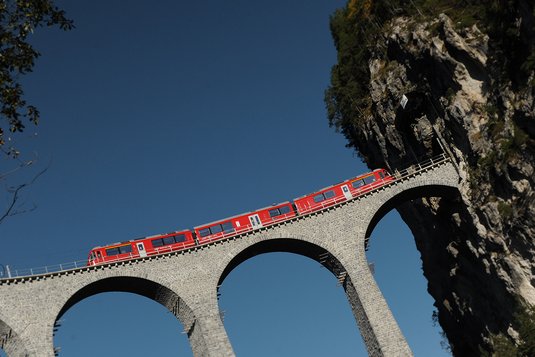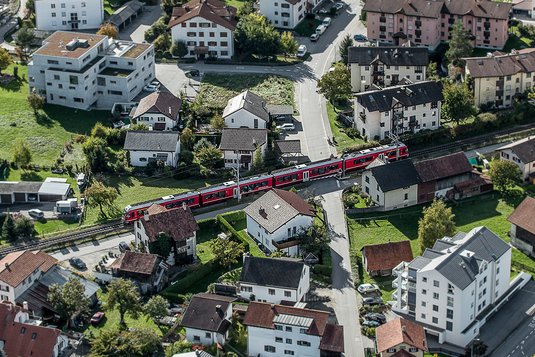Warenkorb
Sie haben keine Produkte im Warenkorb.
Ve zvoleném jazyce nejsou k dispozici všechny obsahy. Chcete se podívat do světa Rhétské dráhy? Přejít na anglický.
The modern Allegra railcars, which began operating on the network of the Rhaetian Railway in 2010, combine elegance with safety. Commuters and tourists appreciate the high degree of comfort.
The Allegra railcars combine power with elegance and comfort. Disabled passengers have no problems boarding and disembarking. Informations screens keeps passengers informed about the progress of their journey.
The three-unit dual-voltage trains can operate on both DC and AC power and are even able to change their power supply system when moving.
Five main line trains of this kind serve commuters in the greater Chur area. They consist of four units: two railcars and two low-floor intermediate cars, which are equipped with an area for wheelchair users, disabled toilet facilities and a multi-functional area.

Allegra dual-voltage railcar.

Allegra main line railcar.
| Allegra dual-voltage railcars | Allegra main line railcars | |
|---|---|---|
| Number of vehicles | 15 | 5 |
| Seats in 1st class | 24 | 24 |
| Seats in 2nd class | 76 | 156 |
| Folding seats | 14 | 22 |
| Output | 2,600 kW | 1,400 kW |
| Top speed | 100 km/h | 100 km/h (techn. 120 km/h) |
Common technical features:
| Railcar number | Name |
|---|---|
| 3101 | Meta von Salis, 1855 – 1929, Historian Women’s rights campaigner Meta von Salis-Marschlins is regarded as Switzerland’s most prominent historian. In 1887 she published an article which, for the first time in German-speaking Switzerland, demanded equal political and legal rights for women. She also maintained a correspondence with Friedrich Nietzsche. |
| 3102 | Richard La Nicca, 1794 – 1883, Engineer Richard La Nicca, a native of Safien-Neukirch, was the first official engineer of the Swiss canton Graubünden. Working in this capacity, he supervised the construction of the major Alpine passes of Julier, Maloja and Bernina. In 1826, he drew up the plans to re-route the Rhine in Domleschg. |
| 3103 | Hortensia von Gugelberg, 1659 – 1715, Author Hortensia von Gugelberg is regarded as an early founder of the Swiss women’s movement. As a successful and self-taught exponent of natural medicine, she received visits from far and wide from people seeking treatment. She lived in Maienfeld. |
| 3104 | Achilles Schucan, 1844 – 1927, First director of the Rhaetian Railway Achilles Schucan was chief engineer and operations manager during the construction of the line from Landquart to Davos. He served as director of the Rhaetian Railway from 1888 to 1909, before chairing the board for a further nine years. |
| 3105 | Angelika Kauffmann, 1741 – 1807, Painter Originally from Chur, she painted most of her major works while living in Italy. Notable commissions included those of Queen Charlotte of England, Emperor Joseph II of Austria and Pope Pious VI. Her salon in Rome attracted classically-inspired artists and travellers from all over Europe. |
| Railcar number | Name |
|---|---|
| 3501 | Willem Jan Holsboer, 1834 - 1898, Founder of the RhB Holsboer, a Dutch sea-captain and businessman, moved to Davos in 1867, on account of his wife’s lung complaint. He became a prominent local figure, after building a spa and treatment centre for visitors from elsewhere. One of his other projects was the construction of the railway line Landquart - Davos, effectively making him the founder of the RhB. |
| 3502 | Friedrich Hennings, 1838 - 1922, The man who built the Albula Line Hennings, a German construction engineer, was involved in the laying of various railway lines in Switzerland. His projects are characterised by the great effort made to ensure that they blend into the natural landscape. He was responsible, as chief engineer between 1898 and 1905, for the construction of the Albula Line. |
| 3503 | Carlo Janka, 1986*, Olympic champion Carlo Janka, who was brought up in the Obersaxen region of Switzerland, is one of the world’s best racing skiers. He won the 2009 world giant slalom championships, and gained an Olympic gold medal for the same discipline in 2010. He also won the 2009/10 World Cup. |
| 3504 | Dario Cologna, 1986*, Olympic champion Dario Cologna, who was brought up in Val Müstair in Switzerland, is the country’s best-ever cross-country skier. In 2013 the three-time Olympic champion also became world champion in the Skiathlon, in addition to winning the Tour de Ski and overall world title, likewise on three occasions. |
| 3505 | Giovanni Segantini, 1858 - 1899, Painter A stateless person, Segantini was educated in Milan, Italy. In 1886, he settled with his family in Savognin, before moving on to Maloja and then Soglio/Bergell. The clear light of the mountains inspired the artist to find a new pictorial language, and he is now regarded, alongside Ferdinand Hodler, as one of the rejuvenators of the Alpine school of painting. |
| 3506 | Anna von Planta, 1858 – 1934, Co-founder of the Cantonal Hospital of Graubünden In 1900, a much-travelled Swiss woman named Anna von Planta set up a convalescent home for poor children in her parents’ villa in Chur. She donated the building to the canton in 1916 for use as a women’s clinic and maternity hospital, which in turn became the present-day Cantonal Hospital of Graubünden. |
| 3507 | Benedetg Fontana, ca. 1450 – 1499, Hero of the battle of the Calven Gorge Fontana, a Swiss political mediator and military leader from Fürstenburg in Vinschgau, is remembered as a hero of the Swabian War of 1499. Mortally wounded at the battle of Calven in the valley of Müstair, he is said to have rallied his men with the final battle-cry: «Men of Graubünden, defend your homeland today or perish forever!» |
| 3508 | Richard Coray, 1869 – 1946, Carpenter This carpenter from the highlands of the Swiss canton of Graubünden created the complex scaffolding used on the most significant bridge structures in Switzerland during the first half of the twentieth century. This required both technical ingenuity and a high level of professional skill on his part. |
| 3509 | Placidus Spescha, 1752 – 1833, Catholic priest and naturalist In 1774, Placidus Spescha entered the Benedictine abbey in Disentis. As an alpinist and naturalist, he was the first climber to conquer various local summits, including Rheinwaldhorn in 1789. Owing much to the humanist-baroque spiritual tradition, he is regarded as one of Switzerland’s leading philosophers of the Enlightenment. |
| 3510 | Alberto Giacometti, 1901 – 1966, Sculptor and painter Bergell-born Alberto Giacometti spent most of his working life in Paris. His work is concerned mainly with the portrayal of the human form under an existential threat. He is regarded as one of the most significant Swiss artists of the twentieth century. |
| 3511 | Otto Barblan, 1860 – 1943, Composer Born in S-chanf, the composer and organist worked mainly in Geneva from 1887. He shaped the world of music there for decades, partly due to his first performances of choral works by Handel, Mozart, Beethoven and Brahms. His pieces often combined late Romantic harmonies with traditional Rhaeto-Romanic songs. |
| 3512 | Jörg Jenatsch, 1596 – 1639, Priest and politician A priest from Grisons, he played an active part in Grisons’ exit from the Thirty Years War; partly due to skilled mediation and the murder of the party leader, Pompejus Planta, at Rietberg Castle. He was hailed as a hero due to the fortuitous ending of the war for Grisons. |
| 3513 | Simeon Bavier, 1825 – 1896, Engineer and politician The civil engineer from Chur was involved in the construction of various pass roads in Grisons. Later, he increasingly turned his attentions to building railways in Switzerland and abroad. He was the first Swiss federal councillor from the canton of Grisons (from 1878 to 1883). |
| 3514 | Steivan Brunies, 1877 – 1953, Co-founder of the Swiss National Park The biologist, born in S-chanf, distinguished himself as a pioneer of nature conservation in Switzerland. He was constantly concerned with bringing young people closer to nature, and not only in his capacity as a teacher. He co-founded the Swiss National Park in the canton of Grisons in 1914. |
| 3515 | Alois Carigiet, 1902 – 1985, Artist The artist, born at Trun near Disentis, created posters and stage designs in his younger years. From 1939 he produced artistic works, inspired by the rural setting of his residence in Obersaxen. He gained international recognition through his illustrations in the children’s book «Schellen-Ursli» (A Bell for Ursli) by Selina Chönz. |